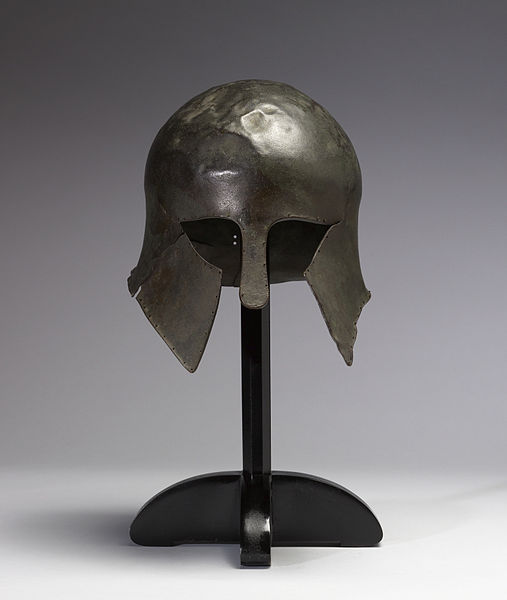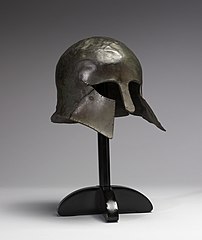Corinthian Hoplite Helmet (Front)
source: Wikimedia Commons
author: Walters Art Museum
Description
A photograph displays the front view of a bronze Corinthian hoplite helmet. Cheekpieces reach down from the side of the helmet to protect the face, as does a nosepiece. The mouth and chin are left exposed with this style.
Date
Artifact: 8th–6th century BC
Photo: 2012
Information
This bronze hoplite helmet bears cheekpieces characteristic of early Corinthian helmets. These cheekpieces appear to have been bent outward, rendering the helmet less effective. This was sometimes done purposefully for ceremonial purposes, such as dedication to sanctuaries.
Hoplite helmets such as this one were one of the pieces of armor worn by athletes competing in the hoplitodromos, an event featured at the Olympic Games and other Panhellenic festivals. In this event, competitors would don a helmet, shield, and (until the 5th century BC) greaves and sprint the distance of the stadium track.
At the time of photograph, this artifact was housed in the Walters Art Museum in Baltimore, Maryland.
Other Versions
Related Articles
Greek Hoplite Armor | Greek Hoplitodromos | Ancient Olympic Games | Panhellenic Games | Greek Stadium
Sekunda, N. (2002). Marathon, 490 BC: The first Persian invasion of Greece. Oxford: Osprey Publishing.
Gat, A. (2008). War in human civilization. Oxford: Oxford University Press.
Sage, M. M. (1996). Warfare in ancient Greece: A sourcebook. London: Routledge.
Scanlon, T. F. (2014). Sport in the Greek and Roman worlds. Vol 1. Oxford: Oxford University Press.


